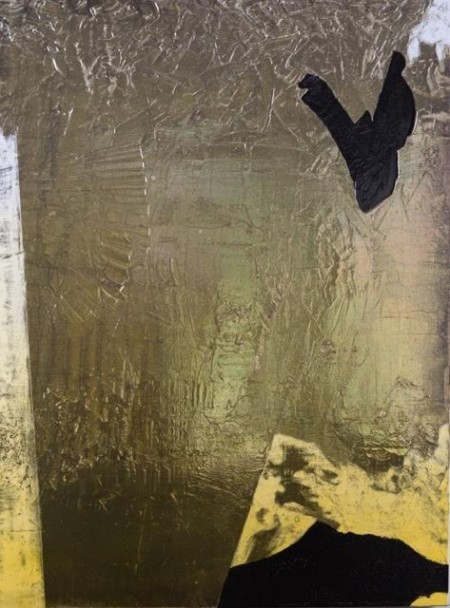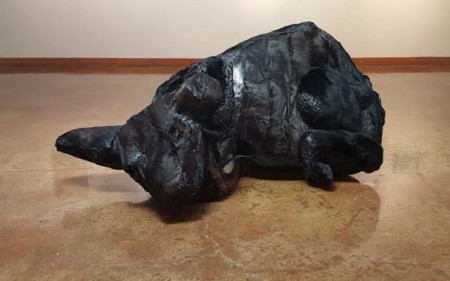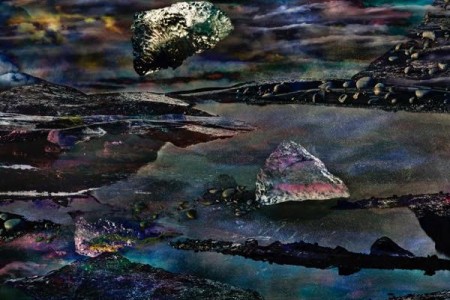On September second K-Space Contemporary opened its tenth annual Third Coast National juried exhibition. The exhibition will remain installed until the fourteenth of October. The exhibition has been historically curated by a long list of Texas heavyweights and this year the juror was well renowned Texas artist Sharon Kopriva who boasts a remarkable oeuvre in sculpture, painting and printmaking. I was there for the opening and for the gallery talk, which occurred the following morning. Both were very well attended. The exhibition was curated from a pool of 600 artists out of which fifty-nine were chosen each presenting a single work.
The work featured in the exhibition was extremely varied and definitely represents Kopriva’s taste for large and figuratively oriented sculpture of shocking bravado. All media were well represented with healthy selections in printmaking, mixed photographic processes, straightforward painting of sculpturally oriented clay works, video installation, collage, mixed media and drawing of course. The subject matter was broad and steered indeterminately in no particular direction, and I would guess that given the number of artists entries choosing a visibly cohesive theme would’ve been virtually impossible. During the Gallery Talks Kopriva, with the help of one of the artists determined that were there to be a theme agreed upon it might be alternate realities, that is, the subjective. Like many juried shows it was generally feel good. There were pieces that I undeniably agreed with, selections that turned me on to artists whom I’m hungry now to know more about. On the other hand there was work that did not strike me deep, however I know, from personal experience, that any broad survey of visual art is hardly ever completely appealing.
The pieces that floored me, and also best-reflected Kopriva’s taste for both the elegant and the grotesque, are as follows:
Trish Igo and Jill O’Brien represented well with their piece entitled “Abject.” The sculpture was essentially a wilted body most easily discernible as that of a calf disfigured through nightmare’s lens. The sculpture was composed of organic animal matter, acquired by the artists through natural deaths (i.e. road kill). It had a large shiny eye, which appeared to be made from resin, highly polished. The body looked as if it had been mangled, bloated, deflated, crumpled like a receipt into the pocket of an unwitting consumer. It was as the title suggests the perfect personification of the word “abject.” The fur was matted, besmeared with tar-black goo and sewn together haphazardly for a bereft ragdoll finish. The head of the body is deceiving too, bifurcated, as if by Picasso, the eyes and ears occupying divided cephalic structures. The composition is obsessive and having read the artist’s statement the personality of the sculpture makes thorough sense. The artists are concerned primarily with the cultural contradiction presented by our societal tendency to fetishize and domestic cute furry animals whilst brutally murdering and consuming the flesh of livestock. Their practice is a remediation of neglect and expression of care-based compulsion, if not somewhat after the fact. The grotesque nature of the work, coupled with its surreal absurd acidness begs inquisitive viewing and critical thinking. I thought the work to be very effective.
Angie Zielinski of Tuscon, AZ was featured on the exhibition post card with her painting Set Up Down. The work is a song of mark making, tactility, and color loosely bridled in the framework of landscape the artist makes an investigation of Americana’s festive detritus. Set Up Down is a joyously explosive display of forms that are loosely derived of the fourth of July, strip mall décor, and dust devils clad in debutant gowns. The brushwork is loose in some places and very tightly dialed in others the artist providing a rich and lyrical application of paint throughout. The line between material experience and creative materiality is therein effectively blurred. Degrees of experimentation are palpable. Most of all the picture plane is well composed and engaging to look at.
Jennifer Thompson’s Just Peachy is a collage composed of imagery sourced from the pages of 1950s era LIFE magazine. Traditionally Thompson works with denim, a fertile ground for American commentary and conversation. This collage similarly deals with America and portions of the piece are hand stitched with embroidery and as much as the collage is well composed and the embroidery well integrated, this work was something I felt like I’ve seen before. Collage has been very popular in recent years, largely I think because it is easily approached and sourced.
Holy Space and Spirit by New York artist (and actor) Lev Gorn is a photo montage of great complexity printed on aluminum through the process of thermal sublimation. In the artist’s statement Gorn describes God as a neuroscientist, he also beautifully disambiguates himself from the process of creation putting the primordial essences of human chemistry before any sort of personal vendetta. The surface of the work was utterly seductive in high gloss. Its purport is cosmic and many layered with a quality not unlike the iridescent pattern of motor oil atop a rain puddle however much more elegantly divined.
Artist Walter Poole’s K2 was an illustrious exploration of surface. Essentially the artist had covered the entire surface of a panel with gold leaf, wrinkled in portions, and polished with a high gloss varnish, the shimmering surface of joy was flanked with areas of white and black . Interestingly the gold was seemingly tarnished in places or perhaps left suspended somewhat in the varnish. The work had an interesting tension about it and made thorough investigation of surface with utterly minimal means, the combination of which established a significant air of mystery inflected somewhat by the title.
The final work I’ll discuss seemed to be the anchor around which the rest of the show was hung. Austin based artist Moses Tsai’s Confined in Frustration featured a life size girl child cast in bronze and tied with elaborate knots of bondage in orange rope that were then tensioned to a large bronze ring on the wall. Elevated by a wooden pallet the sculpture has a commanding weight to it that describes the tension and interstitial nature of being an Asian American. The frustration and political speech of the piece is gravitational in a literal and figurative sense that is jarringly communicative and alarming also.
In summation the exhibition was elaborately populated and wide in the range of its visual survey. K-Space’s Third Coast National continues to grow and evolve and has become a staple of Corpus art calendar. It’s an event that is anticipated and participated healthily. This year’s selection was diverse and offered some incredible sculpture along with thoughtful selection of every media. I would absolutely recommend going to see it if you have the chance and are in the area.
–Jack Wood









